Sponge Gardens
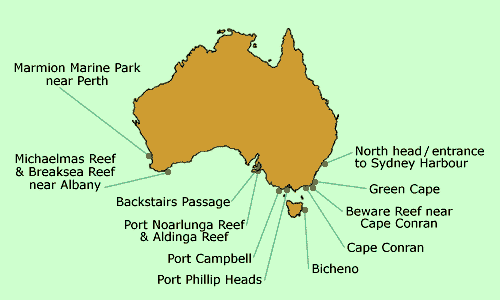
Swim over twenty metres straight down, and you can find sponge gardens.
Like gardens on land, sponge gardens are a beautiful tangle of soft branching corals, sponges, and long thin sea whips. Look out for some of the animals that look like flowers, plants and fruits - sea lilies, sea cucumbers, even sea tulips.
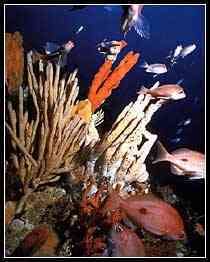
Butterfly Perch, Finger Sponges (Jon Bryan)
Where can you see cold water sponge gardens?
- New South Wales
- Wonderful sponge gardens can be found off North Head at the entrance of Sydney Harbour
- South Australia
- Backstairs Passage
Victor Harbour
Port Norlunga Reef
Aldinga Reef- Tasmania
- Ninepin Point Marine Reserve
- Victoria
- Port Phillip Heads
Whaleback Reef near Point Hicks
Beware Reef near Cape Conran
Off Gabo Island
Green Cape- Western Australia
- Albany: King George Sound, Michaelmas Reef and Breaksea Reef
Marmion Marine Park
Rottnest Island below 5 metres
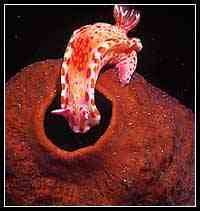
Nudibranch (William Boyle)
What lives here?
On carpets of flat sponges and sea squirts: Jewel anemones, feather-like hydroids, spiral tube worms, barnacles, and bivalves.
Within the sponges: This is the domain of small predators and grazers like segmented worms, sea slugs called nudibranchs, crabs, shrimps and abalone. Colourful sea biscuits, sea stars and spiky urchins are also common. Some graze on tiny algae while others hunt for their supper.
Around the sponges: Many fish species make their homes around the sponges, while others visit
Hiding in caves and crevices: Octopus and cuttlefish live here, keeping a watchful eye out for something tasty to pass by, like crabs.
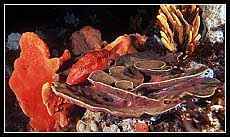
Red Mullet (Mary Malloy)
Dr B. Diversity Tells All
Deep reefs and sponge gardens contain a great diversity of species, many of which are found only in Australia. Temperate (or cold water) sponge gardens are richer in species and are more unique than similar habitats found elsewhere in the world.
Sponge gardens are usually found in low light environments on reefs below 20 metres in depth. Carpets of flat sponges and sea squirts create surfaces that jewel anemones, feather-like hydroids and tube worms attach to. Other animals such as barnacles, spiral tube worms and bivalves add to this rich mosaic of life.
In sponge gardens, every bit of space is used by either a plant or animal. This means that many animals cannot flee predators by hiding in nooks and crannies. Instead these animals have evolved physical and chemical defenses to avoid being eaten:
Sponges produce toxic chemicals that make them taste bad to predators Other sponges have sharp spines, which stop fish and sea urchins from feeding on them.
Scientific knowledge about the species that live in sponge gardens is very poor, and a vast number of them have yet to be properly identified.
Recentlyes., scientists have been examining the natural chemicals made by the animals and plants that live in sponge gardens. Hundreds of new chemicals have been discovered in sponges and sea squirts, and these may hold the key to treat some human disease
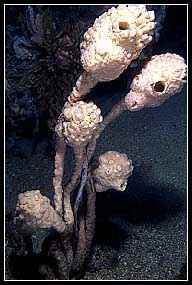
Sea Tulips (Mary Molloy)
Do whales drop-in?
Female southern right whales cruise over and near sponge gardens and related reefs when they move close to shore to give birth. Orcas also swim near sponge reefs.
Here in the year 2050?
At the moment, very few sponge gardens are protected and most have never been studied. The creation of marine protected areas and the introduction of improved fishing methods that minimise damage to the gardens are important for their long term conservation.
- Sponge gardens are delicate habitats. Threats include:
- Being smothered by silt
- Pollution, such as from sewage outfalls and stormwater runoff
- Scallop dredging
- Decrease to some fish species by over-fishing and collection for aquariums
- Introduced species that out compete native species. These include seaweed (such as Undaria), and sea stars transported from foreign waters via ships
- The gradual increase in sea temperature over the past 30 years, which may affect cold water species.
